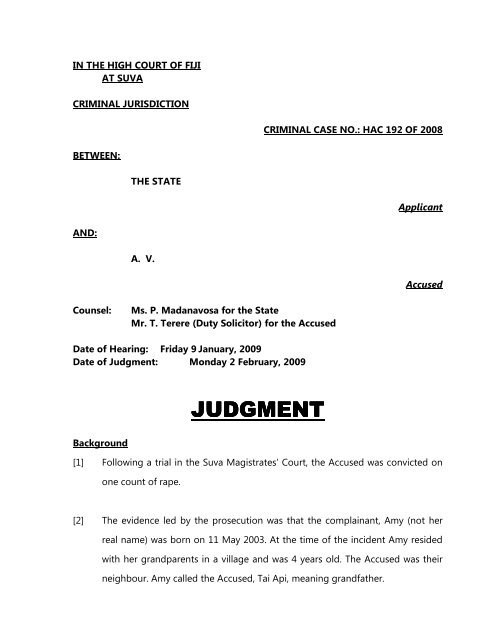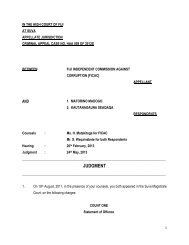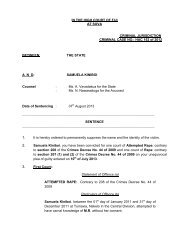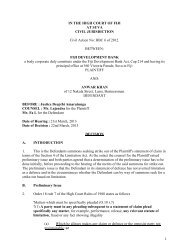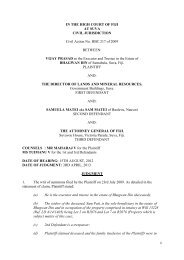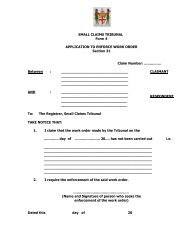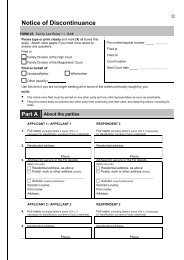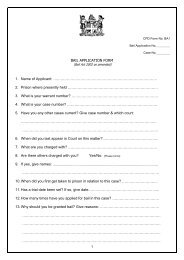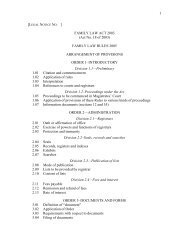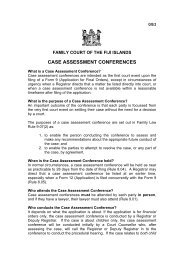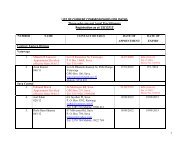A.V v State Judgment. - Judiciary of Fiji
A.V v State Judgment. - Judiciary of Fiji
A.V v State Judgment. - Judiciary of Fiji
Create successful ePaper yourself
Turn your PDF publications into a flip-book with our unique Google optimized e-Paper software.
IN THE HIGH COURT OF FIJI<br />
AT SUVA<br />
CRIMINAL JURISDICTION<br />
BETWEEN:<br />
AND:<br />
THE STATE<br />
A. V.<br />
Counsel: Ms. P. Madanavosa for the <strong>State</strong><br />
Mr. T. Terere (Duty Solicitor) for the Accused<br />
Date <strong>of</strong> Hearing: Friday 9 January, 2009<br />
Date <strong>of</strong> <strong>Judgment</strong>: Monday 2 February, 2009<br />
Background<br />
JUDGMENT<br />
UDGMENT<br />
CRIMINAL CASE NO.: HAC 192 OF 2008<br />
Applicant<br />
Accused<br />
[1] Following a trial in the Suva Magistrates’ Court, the Accused was convicted on<br />
one count <strong>of</strong> rape.<br />
[2] The evidence led by the prosecution was that the complainant, Amy (not her<br />
real name) was born on 11 May 2003. At the time <strong>of</strong> the incident Amy resided<br />
with her grandparents in a village and was 4 years old. The Accused was their<br />
neighbour. Amy called the Accused, Tai Api, meaning grandfather.
2<br />
[3] On 12 October 2007, Amy was playing outside her home when the Accused<br />
called her into his house. He was alone. The Accused carried Amy to his bed<br />
and after fiddling with her vagina, he placed his penis inside it. After this<br />
incident, Amy returned home. When Amy was bathing, she complained to her<br />
aunt about the incident that had occurred at the Accused’s house. When Amy’s<br />
grandmother learnt <strong>of</strong> the sexual assault, she confronted the Accused with<br />
Amy’s complaint. The Accused denied the allegation.<br />
[4] Amy was medically examined on the following day. She relayed the same<br />
complaint to the doctor. According to the doctor, Amy was in a state <strong>of</strong> fear.<br />
Medical examination revealed lacerations on Amy’s vaginal opening. Her<br />
hymen was not intact. The doctor was <strong>of</strong> an opinion that the injuries were<br />
consistent with forceful penetration <strong>of</strong> vagina.<br />
[5] At trial the Accused denied the sexual assault on Amy. The denial was<br />
consistent with his caution statement.<br />
[6] The trial Magistrate found the Accused guilty. After entering conviction, he<br />
transferred the case to the High Court for sentencing pursuant to s.222 <strong>of</strong> the<br />
Criminal Procedure Code which provides:<br />
(1) Where –<br />
(a) a person over the age <strong>of</strong> 17 years is convicted by a<br />
resident magistrate for an <strong>of</strong>fence; and<br />
(b) the magistrate is <strong>of</strong> the opinion (whether by reason <strong>of</strong> the<br />
nature <strong>of</strong> the <strong>of</strong>fence, the circumstances surrounding its<br />
commission or the previous history <strong>of</strong> the accused person)<br />
that the circumstances <strong>of</strong> the case are such that greater<br />
punishment should be imposed in respect <strong>of</strong> the <strong>of</strong>fence<br />
than the magistrate has power to impose, the magistrate
(2) …<br />
3<br />
may, by order, transfer the person to the High Court for<br />
sentencing under Part VII.<br />
(3) The High Court shall enquire into the circumstances <strong>of</strong> the case<br />
and may deal with the person in any manner in which the person<br />
could be dealt with if the person had been convicted by the High<br />
Court.<br />
(4) A person transferred to the High Court under this section has the<br />
same right <strong>of</strong> appeal to the Court <strong>of</strong> Appeal as if the person had<br />
been convicted and sentenced by the High Court.<br />
[7] When the case was called in this Court, I noted after perusing the court record<br />
that that the Accused was prosecuted and convicted on uncorroborated<br />
evidence <strong>of</strong> a child witness which the law explicitly prohibits. The prohibition is<br />
contained in s.10 <strong>of</strong> the Juveniles Act and raises some constitutional issues.<br />
Since the Accused was unrepresented, the Court invited the Legal Aid<br />
Commission to assist him in making submissions.<br />
[8] Mr. Terere from the Legal Aid Commission filed helpful submissions. Counsel<br />
submits that s.10 <strong>of</strong> the Juveniles Act exists to ensure a fair trial for an accused,<br />
and therefore, the section is constitutionally valid. Counsel further submits that<br />
non–adherence to the procedure laid down in s.10 <strong>of</strong> the Juveniles Act is a<br />
procedural defect rendering the conviction unsafe.<br />
[9] I am also grateful to Ms. Madanavosa for her submissions on behalf <strong>of</strong> the<br />
Jurisdiction<br />
<strong>State</strong>. The <strong>State</strong> concedes that the Accused was prosecuted and convicted on<br />
uncorroborated evidence <strong>of</strong> a child complainant. However, the <strong>State</strong> submits<br />
that s.10 <strong>of</strong> the Juveniles Act is unconstitutional because it discriminates<br />
against children <strong>of</strong> certain age and prevents equality before the law.
4<br />
[10] The review <strong>of</strong> the constitutional issue presented in this case is carried out under<br />
the revisionary jurisdiction <strong>of</strong> the High Court which is set out in s.323 <strong>of</strong> the<br />
Criminal Procedure Code:<br />
Revision<br />
Power <strong>of</strong> High Court to call for records<br />
The High Court may call for an examine the record <strong>of</strong> any criminal<br />
proceedings before any magistrates’ court for the purpose <strong>of</strong><br />
satisfying itself as to the correctness, legality or propriety <strong>of</strong> any<br />
finding, sentence or order recorded or passed, and as to the<br />
regularity <strong>of</strong> any proceedings <strong>of</strong> any such magistrates’ court.<br />
[11] Section 325(5) <strong>of</strong> the Criminal Procedure Code states:<br />
Where an appeal lies from any finding, sentence or order, and no appeal<br />
is brought, no proceeding by way <strong>of</strong> revision shall be entertained at the<br />
instance <strong>of</strong> the party who could have appealed.<br />
[12] In this case, the Accused do not have a right <strong>of</strong> appeal against conviction to the<br />
High Court. His right <strong>of</strong> appeal against conviction lies with the Court <strong>of</strong> Appeal<br />
pursuant to s.222 (4) <strong>of</strong> the Criminal Procedure Code. But, if s.10 <strong>of</strong> the<br />
Juveniles Act is held to be constitutionally valid, the conviction entered against<br />
the Accused cannot stand and it would be unjust to sentence the Accused on a<br />
prohibited conviction. Thus, a review is justified. The exercise <strong>of</strong> the revisionary<br />
jurisdiction is without prejudice to the Accused’s right <strong>of</strong> appeal against<br />
conviction to the Court <strong>of</strong> Appeal.<br />
The Constitution<br />
[13] To determine the validity <strong>of</strong> s.10 <strong>of</strong> the Juveniles Act, guidance must be sought<br />
from the Constitution.
5<br />
[14] Section 2 <strong>of</strong> the Constitution states that it is the supreme law and any law<br />
inconsistent with it is invalid to the extent <strong>of</strong> the inconsistency. The<br />
Constitution protects the fundamental rights and freedoms <strong>of</strong> every person in<br />
this country and all judges are bound to uphold those rights (s. 21 (1) (a) <strong>of</strong> the<br />
Constitution).<br />
[15] Every person has the right to equality before the law and must not be unfairly<br />
discriminated against, directly or indirectly, on the ground <strong>of</strong> his or her age (s.<br />
38 (1) & (2) (a) <strong>of</strong> the Constitution). However, a law which appears to<br />
differentiate or discriminate will not be inconsistent with the equality clause if<br />
that law is reasonable and justifiable in an open and democratic society. The<br />
test for discriminatory law is whether it exists to advance a legitimate purpose<br />
(Balkandali v UK EHRR 28/5/85 applied by Shameem J in <strong>State</strong> v Baleinabuli<br />
& Ors Cr Case No. HAC106/06).<br />
Is s.10 <strong>of</strong> the Juveniles Act constitutionally valid?<br />
[16] Section 10 <strong>of</strong> the Juveniles Act states:<br />
(1) Where in any proceedings against any person for any<br />
<strong>of</strong>fence or in any civil proceedings any child <strong>of</strong> tender years called<br />
as a witness does not in the opinion <strong>of</strong> the court understand the<br />
nature <strong>of</strong> an oath, his evidence may proceed not on oath, if, in the<br />
opinion <strong>of</strong> the court, he is possessed <strong>of</strong> sufficient intelligence to<br />
justify the reception <strong>of</strong> his evidence and to understand the duty<br />
<strong>of</strong> speaking the truth; and the evidence though not given on oath<br />
but otherwise taken and reduced into writing so as to comply<br />
with any law in force for the time being, shall be deemed to be a<br />
deposition within the meaning <strong>of</strong> any law so in force:<br />
Provided that where evidence is admitted by virtue <strong>of</strong> this section<br />
on behalf <strong>of</strong> the prosecution, the accused shall not be liable to be<br />
convicted <strong>of</strong> the <strong>of</strong>fence unless that evidence is corroborated.
6<br />
[17] To understand the rationale behind s.10 <strong>of</strong> the Juveniles Act, it is important to<br />
look at its history which is linked to the Children and Young Person Act 1933<br />
(UK). Section 10 is based on s. 38(1) <strong>of</strong> the Children and Young Person Act 1933<br />
(UK). Most common law countries enacted similar laws. The Juveniles Act was<br />
enacted in <strong>Fiji</strong> in 1974.<br />
[18] Under s.10 <strong>of</strong> the Juveniles Act, the trial magistrate or judge must first hold an<br />
enquiry as to the competence <strong>of</strong> a child witness who is below the age <strong>of</strong> 14<br />
years using oath as a standard. If the child passes the oath test, he or she is<br />
permitted to give evidence. If the child does not pass the oath test, he or she is<br />
competent to give evidence provided he or she possess sufficient intelligence<br />
to justify reception <strong>of</strong> the evidence, but the evidence must be corroborated.<br />
[19] A failure to hold an inquiry into the competency <strong>of</strong> a child witness has resulted<br />
in the conviction being quashed (Lal Khan (1981) 73 Cr App R 190, Fazal<br />
Mohammed v the <strong>State</strong> (1990) 91 Cr App R 256, C. A. Z. (1990) 91 Cr App R<br />
203, Suresh Chand v R Ltk Cr App No. 77/83, Kepueli Jitoko v the <strong>State</strong><br />
[1991] 37 FLR 14, Mohammed Salim Nur Khan v The <strong>State</strong> Cr App No.<br />
HAA004 <strong>of</strong> 2008)<br />
[20] The obligation to hold a preliminary enquiry into competency is not the only<br />
restriction for the reception <strong>of</strong> evidence <strong>of</strong> a child witness below the age <strong>of</strong> 14<br />
years. The strength <strong>of</strong> the restriction to give evidence in court proceedings<br />
depends on whether the child gives evidence on oath or unsworn evidence. A<br />
child may give evidence on oath or unsworn, but in either case there is a need<br />
for corroboration <strong>of</strong> the evidence <strong>of</strong> a child.<br />
[21] There is a total ban on convicting an accused on the uncorroborated evidence<br />
<strong>of</strong> a child witness who gives unsworn evidence, whatever the nature <strong>of</strong> the
7<br />
charge. In effect if the prosecution cannot produce more than just the word <strong>of</strong><br />
a child witness, no matter how convincing the child witness is, the prosecution<br />
must be stopped.<br />
[22] Corroboration is evidence independent <strong>of</strong> the witness to be corroborated<br />
which confirms in some material particular not only that the crime was<br />
committed but that the accused committed it (R v Baskerville (1910) 2 KB<br />
658).<br />
[23] Then there is an additional requirement for a warning to act on a child’s<br />
evidence even if the child is competent witness. This rule <strong>of</strong> practice is based on<br />
common law and was adopted in this country from England. In giving the<br />
warning, the Magistrate or Judge must use the word “dangerous”, or some<br />
other word which is equally strong (Trigg [1963] 47 Cr. App. R.94). Merely<br />
approaching the evidence <strong>of</strong> a child witness with caution will not do (Gammon<br />
[1959] 43 Cr. App. R.155). A failure to give a warning to a child witness’s sworn<br />
evidence will almost certainly result in the conviction being quashed on appeal<br />
no matter how strong was the evidence (Trigg (supra)).<br />
[24] Adult witnesses are not subject to similar restrictions as imposed on children by<br />
s.10 <strong>of</strong> the Juveniles Act. In criminal proceedings, evidence <strong>of</strong> a person may be<br />
received on oath or affirmation. This is a statutory right <strong>of</strong> every person which<br />
is contained in s.136 <strong>of</strong> the Penal Code. If evidence is received on affirmation,<br />
the evidence has the same force and effect as if it had been taken on oath (s.2<br />
<strong>of</strong> the Oaths Act, Cap 42). The provision for reception <strong>of</strong> evidence on<br />
affirmation is consistent with the constitutional right to freedom <strong>of</strong> conscience,<br />
religion and belief and the right not to be compelled to take an oath, or to take<br />
an oath in a manner, that is contrary to his or her religion or belief or that<br />
requires him or her to express a belief that he or she does not to hold (s. 35 (1)
8<br />
& (6) <strong>of</strong> the Constitution). Children under the age <strong>of</strong> 14 years are deprived <strong>of</strong><br />
these rights by s. 10 <strong>of</strong> the Juveniles Act.<br />
[25] These rules restricting the reception <strong>of</strong> evidence <strong>of</strong> child witnesses are based<br />
on the widespread belief that children are unreliable, particularly when they are<br />
testifying about sexual assault. Children are placed in the same category as<br />
women whose evidence required corroboration warning if they complained <strong>of</strong><br />
sexual assault. In DPP v Hester (1972) 57 Cr App R 212, Lord Morris at p. 219<br />
said:<br />
“The accumulated experience <strong>of</strong> courts <strong>of</strong> law, reflecting accepted<br />
general knowledge <strong>of</strong> the ways <strong>of</strong> the world, has shown that there<br />
are many circumstances and situations in which it is unwise to<br />
found settled conclusions on the testimony <strong>of</strong> one person alone.<br />
The reasons for this are diverse. There are some suggestions<br />
which can readily be made, but which are only with more<br />
difficulty rebutted. There may in some cases be motives <strong>of</strong> selfinterest,<br />
or <strong>of</strong> self-exculpation, or <strong>of</strong> vindictiveness. In some<br />
situations the straight line <strong>of</strong> truth is diverted by the influences <strong>of</strong><br />
emotion or <strong>of</strong> hysteria or <strong>of</strong> alarm or <strong>of</strong> remorse. Sometimes it<br />
may be that owing to immaturity or perhaps to lively imaginative<br />
gifts there is no true appreciation <strong>of</strong> the gulf that separates truth<br />
from falsehood. It must, therefore, be sound policy to have rules<br />
<strong>of</strong> law or <strong>of</strong> practice which are designed to avert the peril that<br />
findings <strong>of</strong> guilt may be insecurely based. So it has come about<br />
certain statutory enactments impose the necessity in some<br />
instances <strong>of</strong> having more than one witness before there can be a<br />
conviction. So also has it come about that in other instances the<br />
Courts are given guidance in terms which have become rules.<br />
Included in such cases are those in which charges <strong>of</strong> sexual<br />
<strong>of</strong>fences are made… Also included in the types <strong>of</strong> cases above<br />
referred to are those in which children are witnesses.”
9<br />
[26] However, in 1991, England made major changes to the area <strong>of</strong> evidence <strong>of</strong><br />
child witnesses in court proceedings by enacting the Criminal Justice Act 1991.<br />
The presumption <strong>of</strong> incompetence which applied to children <strong>of</strong> tender years<br />
was removed. The Act allows children under the age <strong>of</strong> 14 to give unsworn<br />
evidence and to substitute a pre-recorded interview with a child witness for the<br />
child’s evidence in chief in cases involving certain sexual <strong>of</strong>fences and <strong>of</strong>fences<br />
<strong>of</strong> violence or cruelty. Where this is done the child is still cross-examined in the<br />
conventional way at trial, using the line link where appropriate. These<br />
legislative reforms were inspired by the report <strong>of</strong> the Home Office’s Advisory<br />
Group on Video Evidence, December 1989 (chairman Judge Pigot QC).<br />
Paragraph 5.13 <strong>of</strong> the report read:<br />
“…we believe the competence requirement which is applied to<br />
potential child witnesses should be dispensed with and that it<br />
should not be replaced. Once any witness has begun to testify he<br />
or she may appear to be <strong>of</strong> unsound mind, become incoherent or<br />
fail to communicate in a way that makes sense. The judge is<br />
already able to rule such a witness incompetent and to advise the<br />
jury to ignore any evidence that may have been given. We think<br />
that this power, applied where necessary at the preliminary<br />
hearing or trial, is all that is needed…”<br />
[27] The Pigot Report at paragraph 5.15 suggested that instead <strong>of</strong> conducting an<br />
inquiry, the trial judge in the presence <strong>of</strong> the jury and the accused remind the<br />
child, <strong>of</strong> the importance <strong>of</strong> telling the truth, along the following lines:<br />
Tell us all you can remember <strong>of</strong> what happened. Don’t make anything up<br />
or leave anything out. This is very important.<br />
[28] In R v Hampshire [1995] 2 ALL ER 1019, the English Court <strong>of</strong> Appeal at p. 1025<br />
made the following observations in relation to the effect <strong>of</strong> the legislative<br />
reforms in England:
10<br />
In our view, the effect <strong>of</strong> the recent statutory changes has been to<br />
remove from the judge any duty to conduct a preliminary<br />
investigation <strong>of</strong> a child’s competence, but to retain his power to<br />
do so if he considers it necessary, say because the child is very<br />
young or has difficulty in expression or understanding. …Whether<br />
or not he conducts such a preliminary investigation, he has the<br />
same duty as in the case <strong>of</strong> an adult witness, namely to exclude or<br />
direct disregard <strong>of</strong> the evidence, if and when he concludes that<br />
the child is not competent.<br />
[29] The English Court <strong>of</strong> Appeal held that the object <strong>of</strong> the reforms was to apply to<br />
children the ordinary test <strong>of</strong> competence regardless <strong>of</strong> any real or notional<br />
additional test previously imposed on them if they gave evidence on oath, such<br />
as a requirement to determine whether the child understands the special<br />
importance <strong>of</strong> telling the truth in a court in addition to his or her duty to do so<br />
as part <strong>of</strong> normal social conduct.<br />
[30] Similar legislative reforms have taken place in most common law countries.<br />
Unfortunately, <strong>Fiji</strong>’s legislature has not changed the law which stands contrary<br />
to the principle <strong>of</strong> equality before the law provided by the Constitution.<br />
However, the courts do not have to wait for the legislature to bring about<br />
changes to the laws that are inconsistent with the Constitution. If a law enacted<br />
by the Parliament is inconsistent with Constitution, the Constitution gives the<br />
courts mandate to strike down the law as being void.<br />
[31] In the case <strong>of</strong> Seremaia Balelala v The <strong>State</strong> Criminal Appeal No. AAU003 <strong>of</strong><br />
2004 the Court <strong>of</strong> Appeal in rejecting the notion that women in sexual assault<br />
cases have tendency to fabricate stories based on “ulterior motives” and<br />
therefore are less capable <strong>of</strong> belief, struck down the rule <strong>of</strong> practice which
11<br />
required corroboration, or a warning that it is dangerous to act on the<br />
uncorroborated evidence, in cases <strong>of</strong> sexual assault, so as to give full effect to<br />
the equality guarantee in the Constitution.<br />
[32] In a recent case <strong>of</strong> Agnu v <strong>State</strong> Cr App No. HAA067/08 (5 September 2008),<br />
the High Court made the following observations about the law on the evidence<br />
<strong>of</strong> children as it stands now:<br />
The law <strong>of</strong> the evidence <strong>of</strong> children is that where a child gives<br />
unsworn evidence, corroboration is required as a matter <strong>of</strong> law.<br />
That means that without corroboration, a conviction is impossible.<br />
Where however a child gives sworn evidence, a corroboration<br />
warning should be given as a matter <strong>of</strong> practice on the basis that<br />
the evidence <strong>of</strong> children may be unreliable without some<br />
supporting evidence independent <strong>of</strong> the child and implicating the<br />
accused. This rule is left untouched by the Court <strong>of</strong> Appeal<br />
decision in Seremaia Balelala v The <strong>State</strong> [2004] AAU003.2004S,<br />
which dealt with corroboration in sexual cases. In that case, the<br />
court found that the law on corroboration as it impacted on<br />
women, was based on myths about female behaviour, and “a<br />
wide range <strong>of</strong> reasons, including a supposed tendency in women<br />
to engage in fantasy, to be fickle or spiteful in sexual<br />
relationships, to be prone to sexual neurosis, or to be unwilling to<br />
admit to consent out <strong>of</strong> shame.” The Court <strong>of</strong> Appeal held that<br />
these reasons and myths” … reflected a flawed understanding <strong>of</strong><br />
the world, they have been unfairly demeaning <strong>of</strong> women, and<br />
they have been discredited by law makers in more recent times.”<br />
At page 11 <strong>of</strong> the judgment the court held:<br />
“…it would henceforth be a matter for discretion, in<br />
accordance with the general law, for a judge to give<br />
a warning or a caution, wherever there was some<br />
particular aspect <strong>of</strong> the evidence giving rise to a<br />
question as to its reliability.”
12<br />
In sexual cases therefore the mandatory requirement for a<br />
corroboration warning was abolished in Balelala. However the<br />
common law rule that the sworn evidence <strong>of</strong> children requires a<br />
corroboration warning irrespective <strong>of</strong> the charge, was not the<br />
subject <strong>of</strong> the decision. There was a suggestion that a warning or<br />
caution might be given where the complainant “was shown by<br />
reason <strong>of</strong> age or mental disability to be questionable as to her<br />
veracity” but the court did not deal specifically with the sworn<br />
evidence <strong>of</strong> children. If this case before me, is referred to the<br />
Court <strong>of</strong> Appeal, it may be an opportune occasion to consider<br />
whether the sworn evidence <strong>of</strong> children requires a corroboration<br />
warning, and whether it is an inequality before the law to treat<br />
the evidence <strong>of</strong> children as inherently unreliable as the evidence<br />
<strong>of</strong> accomplices.<br />
[33] Section 10 <strong>of</strong> the Juveniles Act is clearly based on myths and stereotypes about<br />
children, that is, they fabricate stories based on ulterior motives. The<br />
requirement for a preliminary investigation into the child’s competence before<br />
the child can testify is to justify the need for corroboration or a warning if the<br />
child’s evidence is to be accepted. In my view, myths and stereotypes have no<br />
place in a rational system <strong>of</strong> law, as they jeopardize the courts’ truth-finding<br />
function. The belief that children fabricate stories based on ulterior motives and<br />
are therefore less capable <strong>of</strong> belief is not supported by judicial experience or<br />
social science research. I cannot find any rationale for discriminating against<br />
children who are subjected to the restrictions imposed by s.10 <strong>of</strong> the Juveniles<br />
Act. The impact <strong>of</strong> the discrimination has been grossly unjust to children who<br />
were violated but denied access to justice. Due process is not a concept that is<br />
only available to an accused. Due process is also available to the victims <strong>of</strong><br />
crime.<br />
[34] Children below the age <strong>of</strong> 14 years are the most vulnerable victims, and<br />
therefore, the need for protection <strong>of</strong> law is greater. A law that prohibits<br />
prosecution and conviction <strong>of</strong> persons, who commit crime against children
13<br />
regardless <strong>of</strong> their age, deprives the children the due process <strong>of</strong> law. Such law<br />
has no place in our criminal justice system. This interpretation is consistent with<br />
the Convention on the Rights <strong>of</strong> the Child which <strong>Fiji</strong> ratified in 1993. By ratifying<br />
the Convention, the <strong>State</strong> is obliged to take all appropriate legislative measures<br />
to protect the children <strong>of</strong> this country from all forms <strong>of</strong> physical or mental<br />
violence, injury or abuse, or exploitation or sexual abuse. The Convention also<br />
allows for judicial involvement to carry out the protective measures for children.<br />
[35] I hold that s.10 <strong>of</strong> the Juveniles Act discriminates against children because <strong>of</strong><br />
their age and deprives them the equality before the law as guaranteed by the<br />
Constitution. I hold that s.10 <strong>of</strong> the Juveniles Act must be considered as<br />
stricken from the said Act. I further hold that the common law requirement for<br />
corroboration <strong>of</strong> evidence <strong>of</strong> children to be unconstitutional for the same<br />
reasons.<br />
[36] If a child <strong>of</strong> a tender age appears in court as a witness, the only obligation the<br />
magistrate or the judge has is to remind the child <strong>of</strong> the importance <strong>of</strong> telling<br />
the truth before receiving his or her evidence and that evidence should be<br />
assessed like the evidence <strong>of</strong> any other witness without the need for<br />
corroboration or a warning.<br />
[37] For these reasons, I confirm the conviction entered against the Accused.<br />
At Suva<br />
……………………………….<br />
Daniel Goundar<br />
JUDGE
Monday 2 February, 2009<br />
14<br />
Solicitors:<br />
Office <strong>of</strong> the Director <strong>of</strong> Public Prosecutions, Suva for the <strong>State</strong><br />
Legal Aid Commission, Govt. Buildings, Suva for the Accused


